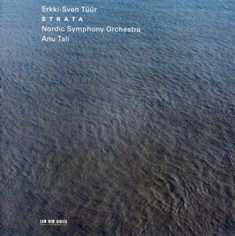
Anu Tali and the Nordic Symphony Scale Tüür

|
Tüür began his musical career as a progressive rock artist with his own band, In Spe, in his native country. He is a master of instrumental color. For him, sound is a structural element, replacing thematic development and harmonic design. He utilizes what he calls a "vectorial" method of composition, using a "source code" of intervallic relationships to impart structure. His music draws upon the vast resources of the late romantic orchestra and an unlimited variety of musical languages.
The word "strata" means "layers" and I can think of no better analogy for his 32-minute Sixth Symphony than a cave, where time has laid down layers of rock through the action of water filtering through them. The grandeur of the work carries the same connotation in an emotional sense, i.e. of immensity and awe. The movements flow into one another without a break (Tüür dislikes interruptions to avoid extraneous noise). It begins vigorously, with a percussive thud followed by a big decrescendo, as if one's eyes were growing accustomed to the darkness in a cave.
What presents itself is a fluttering of strings, bowed vibraphone and a big sizzle of cymbal. Dynamics play an important role, as the volume waxes and wanes. There is a bubbling up of harp and piano. Woodwind swirls induce a vertiginous feel.
The activity levels off at the beginning of the next movement with a lovely snatch of melody in the strings (perhaps a layer of crystal encountered in the cave). The strings proceed as if reaching for the same pitch, before the full orchestra, led by pounding timpani, returns to the scene. After a big buildup, the strings retreat, haloed by the winds, and there is a bubbling up of vibraphone and piano (compare the first movement). The final movement introduces fragments of an Estonian folk song, first heard in the lower strings. This becomes an ostinato of sorts that resolves once again in that mysterious bubbling, spreading effect. There is a brightening of brass, followed by big timpani strokes and a climax before the music dissolves into a haze of strings and percussion for a soft, ethereal effect.
"Noesis" means "cognition," or to put it more simply in the context of this concerto, "getting to know you." That is the feeling one gets from Tüür's treatment of the clarinet and violin. The orchestra introduces the soloists (brother and sister), who perform separately at first, the violin in quasi-cadenza style, which the clarinet imitates. In the next movement, the instruments spar against a very lively orchestral background. Eventually they twine around each other and reach a state of (almost) harmony. The final section is jazzy and dance-like, with the orchestra joining in the jubilation. The clarinet asserts itself as it had at the beginning before the concerto ends with the two soloists sounding a soft, diminished interval.
(first published at www.concertonet.com)